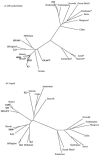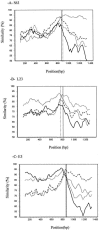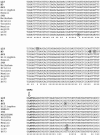Characterization of new recombinant noroviruses
- PMID: 16207981
- PMCID: PMC1248523
- DOI: 10.1128/JCM.43.10.5179-5186.2005
Characterization of new recombinant noroviruses
Abstract
Noroviruses are important etiologic agents of acute gastroenteritis and show great genetic diversity. To characterize more fully previously detected strains that could not be assigned unequivocally to one particular genotype based on the RNA polymerase, we have sequenced a region in the capsid gene and, in some cases, in the junction between open reading frame 1 (ORF 1) and ORF 2. The results allowed us to identify several recombinant noroviruses: GGIIb viruses were detected for the first time in France in August 2000 and then spread through France and to Europe during the following winter. Here we present the characterization of three other probable GII recombinants which showed different phylogenetic positions depending on their ORF 1 and ORF 2 sequences. Analysis of the region located between ORF 1 and ORF 2 by a nucleotide identity window search showed a sudden shift in similarities. Moreover, recombination breakpoints were identified upstream and downstream of the beginning of ORF 2 by using a statistical test, thus confirming the involvement of this region in recombination. Unlike GGIIb, the three recombinants described here do not seem to have diffused widely in the community: one was found in a waterborne outbreak, and the other two were found in sporadic cases. Recombination is important for the evolution of RNA viruses and has already been described for noroviruses. Our results suggest that recombination is not a rare phenomenon among noroviruses, but not all these presumed recombinants that formed during RNA replication are able to spread widely.
Figures



References
-
- Anderson, A. D., A. G. Heryford, J. P. Sarisky, C. Higgins, S. S. Monroe, R. S. Beard, C. M. Newport, J. L. Cashdollar, G. S. Fout, D. E. Robbins, S. A. Seys, K. J. Musgrave, C. Medus, J. Vinje, J. S. Bresee, H. M. Mainzer, and R. I. Glass. 2003. A waterborne outbreak of Norwalk-like virus among snowmobilers—Wyoming, 2001. J. Infect. Dis. 187:303-306. - PubMed
-
- Ando, T., J. S. Noel, and R. L. Fankhauser. 2000. Genetic classification of “Norwalk-like viruses.” J. Infect. Dis. 181(Suppl. 2):S336-S338. - PubMed
-
- Bon, F., H. Giraudon, C. Sancey, C. Barranger, M. Joannes, P. Pothier, and E. Kohli. 2004. Development and evaluation of a new commercial test allowing the simultaneous detection of noroviruses and sapoviruses by reverse transcription-PCR and microplate hybridization. J. Clin. Microbiol. 42:2218-2220. - PMC - PubMed
-
- Buesa, J., B. Collado, P. Lopez-Andujar, R. Abu-Mallouh, J. Rodriguez Diaz, A. Garcia Diaz, J. Prat, S. Guix, T. Llovet, G. Prats, and A. Bosch. 2002. Molecular epidemiology of caliciviruses causing outbreaks and sporadic cases of acute gastroenteritis in Spain. J. Clin. Microbiol. 40:2854-2859. - PMC - PubMed
Publication types
MeSH terms
Substances
Associated data
- Actions
- Actions
- Actions
LinkOut - more resources
Full Text Sources
Other Literature Sources
Medical

